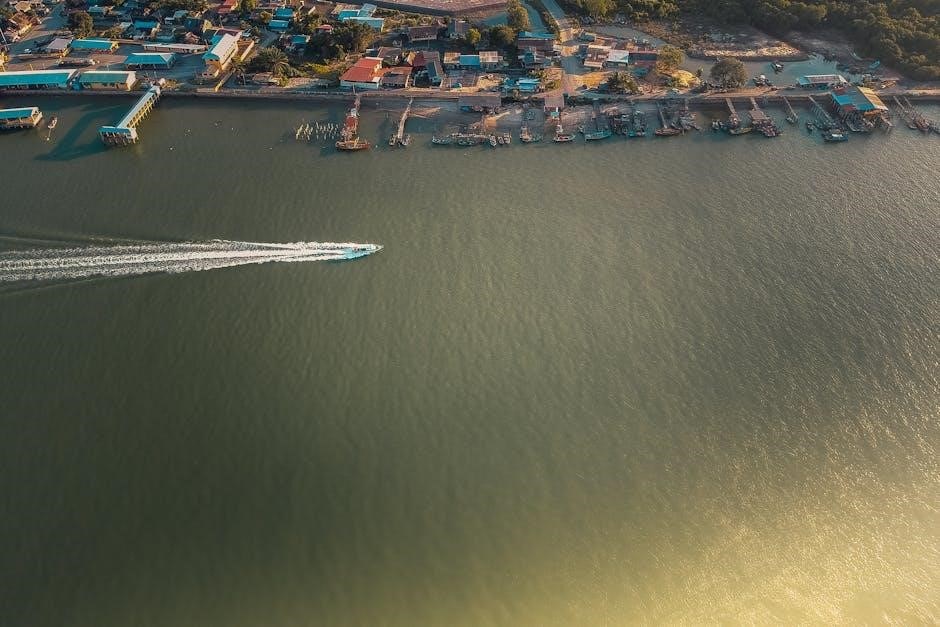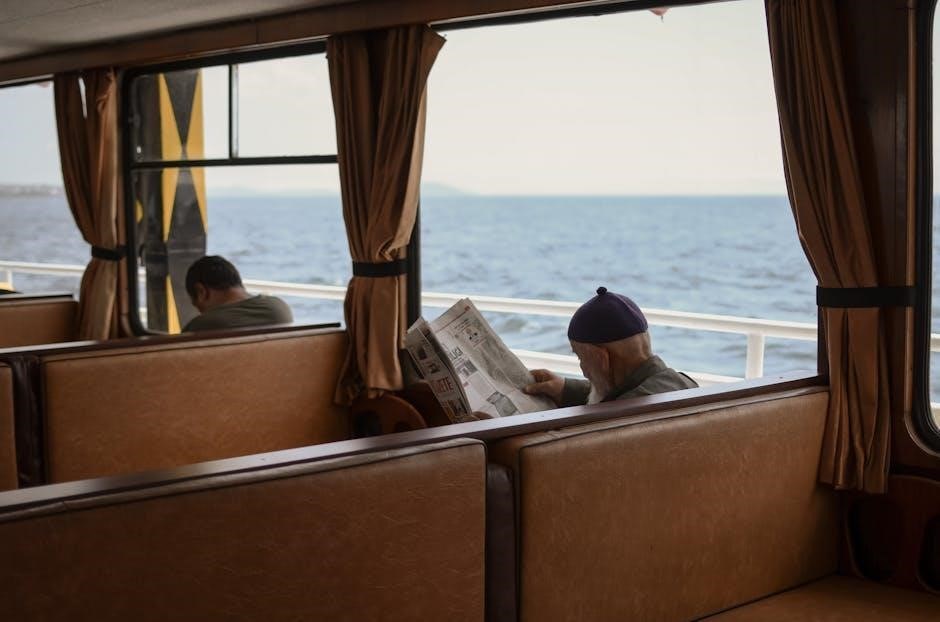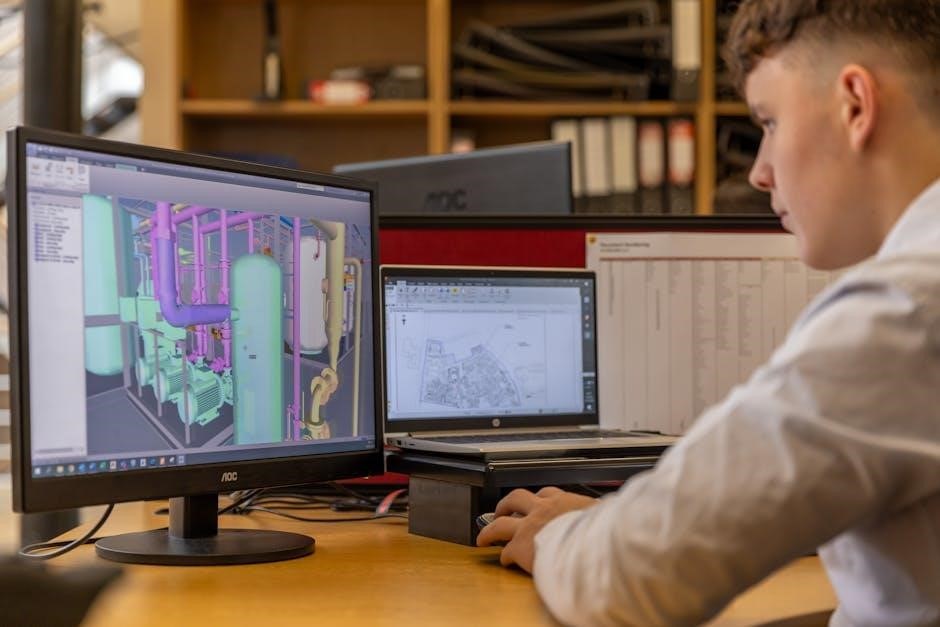Marine freezer refrigeration systems are essential for preserving perishables and maintaining optimal temperatures on ships. These systems are designed to withstand harsh marine environments, ensuring reliability and efficiency in cooling operations.
1.1 Overview of Marine Refrigeration Technology
Marine refrigeration technology involves advanced systems designed to maintain precise temperatures for preserving perishables. These systems integrate compressors, condensers, and evaporators to facilitate heat exchange. The technology ensures efficient cooling, even in harsh marine conditions. Modern designs emphasize energy efficiency, durability, and compact layouts. Blueprint diagrams and schematics are crucial for understanding system layouts, component interactions, and refrigerant flow. This technology is vital for food storage, cargo cooling, and maintaining optimal conditions in marine environments, ensuring operational reliability and performance.
1.2 Importance of Freezer Systems in Marine Applications
Freezer systems are crucial in marine applications for preserving food, preventing spoilage, and ensuring crew health. They maintain optimal temperatures for perishable goods, extending shelf life. These systems are essential for food storage, cargo cooling, and provisioning. They ensure operational efficiency, safety, and sustainability at sea. Reliable freezer systems are vital for maintaining food quality and preventing waste, making them indispensable in marine operations.

Key Components of Marine Freezer Refrigeration Systems
Marine freezer systems rely on compressors, condensers, evaporators, expansion valves, and refrigerants. These components work together to achieve efficient cooling, essential for preserving perishables and maintaining low temperatures.
2.1 Compressors and Their Role in the System

Compressors are the heart of marine freezer systems, driving the refrigeration cycle by compressing refrigerant vapor, raising its temperature and pressure. They ensure efficient heat transfer in condensers, enabling the system to maintain low temperatures. Durable designs withstand marine environments, with options like 1/4 HP or 3/8 HP models. Proper sizing is crucial to handle cooling loads, ensuring optimal performance without overloading. Regular maintenance, including oil checks and filter cleaning, is essential for longevity and efficiency. Compressors are central to system reliability and functionality.
2.2 Condensers and Evaporators: Design and Functionality
Condensers and evaporators are critical components in marine freezer systems, enabling efficient heat exchange. Condensers dissipate heat from the refrigerant to the surrounding environment, often using water or air. Evaporators absorb heat from the refrigerated space, causing the refrigerant to evaporate. Both components are designed for marine durability, with materials like titanium and copper-nickel to resist corrosion. Proper sizing and placement ensure optimal performance, maintaining desired temperatures for food preservation and cargo cooling. Their functionality is vital for system efficiency and reliability in harsh marine conditions.
2.3 Expansion Valves and Refrigerant Flow Control

Expansion valves regulate refrigerant flow, ensuring precise control of pressure and temperature in marine freezer systems. They reduce refrigerant pressure before it enters the evaporator, enabling efficient heat absorption. Thermostatic and electronic expansion valves are commonly used, with the latter offering advanced control for modern systems. Proper installation and adjustment are critical to maintain optimal refrigerant flow, preventing overcooling or undercooling. These valves are essential for system performance, ensuring reliable operation in demanding marine environments while minimizing energy consumption.

Blueprint and Schematic Diagram
A blueprint and schematic diagram are essential for understanding the layout and functionality of marine freezer systems. These visuals detail components, connections, and refrigerant flow, aiding installation and maintenance.
3.1 Understanding the System Layout and Functionality
The blueprint and schematic diagram provide a detailed visual representation of the marine freezer refrigeration system. These diagrams illustrate the placement and interconnection of key components such as compressors, condensers, evaporators, and expansion valves. They also depict the flow of refrigerant through the system, highlighting how each part contributes to the overall cooling process. By analyzing these diagrams, users can better comprehend the system’s operational flow, ensuring proper installation, maintenance, and troubleshooting. This visual guide is indispensable for optimizing system performance and addressing potential issues efficiently.
3.2 Key Symbols and Legends in the Blueprint
The blueprint of a marine freezer refrigeration system includes specific symbols and legends to represent components and their connections. Common symbols depict compressors, condensers, evaporators, and expansion valves, while arrows indicate refrigerant flow. The legend provides a key to understanding these symbols, ensuring clarity in interpreting the system’s layout. This standardized representation aids technicians in identifying components, troubleshooting, and performing maintenance efficiently. The symbols and legends are essential for accurately interpreting the system’s design and functionality, making the blueprint a critical tool for installation and operation. Proper understanding of these elements ensures optimal system performance and longevity.
Design Considerations for Marine Freezer Systems
Designing marine freezer systems requires balancing space constraints, durability, and energy efficiency. Systems must withstand corrosive environments and operate efficiently to minimize costs and environmental impact.
4.1 Space and Weight Constraints in Marine Environments
Space and weight constraints are critical in marine environments, as ships have limited room for equipment. Marine freezer systems must be compact and lightweight while maintaining efficiency. Designers often use modular components and optimized layouts to minimize footprint. Energy-efficient compressors and condensers are selected to reduce both size and power consumption. Additionally, lightweight materials like aluminum are employed to lower overall weight without compromising durability. These considerations ensure systems meet the tight spatial and operational demands of marine applications while maintaining performance and reliability.
4.2 Durability and Resistance to Corrosion
Durability and corrosion resistance are vital for marine freezer systems, as they operate in salty, humid environments. Components are made from corrosion-resistant materials like stainless steel and titanium to withstand seawater exposure. Protective coatings and cathodic protection are applied to prevent metal degradation. Sealed electrical connections and waterproof enclosures safeguard against moisture ingress. These measures ensure long-term reliability and minimize maintenance needs, critical for uninterrupted operation at sea. Robust construction and anti-corrosion treatments are essential for maintaining system integrity in harsh marine conditions.
4.3 Energy Efficiency and Cost-Effectiveness
Energy efficiency is crucial for marine freezer systems to minimize operational costs and reduce environmental impact. Advanced compressors and evaporators optimize cooling while lowering power consumption. Smart controls and variable-speed technology adjust energy use based on load demands. Insulation and airflow management reduce heat loss, enhancing overall efficiency. These designs ensure cost-effectiveness by reducing fuel consumption and extending system lifespan. Energy-efficient systems also comply with marine regulations, making them a sustainable choice for modern vessels.

Applications of Marine Freezer Refrigeration Systems
Marine freezer systems are vital for food storage, cargo cooling, and galley operations on ships, ensuring perishables remain fresh and cargo is preserved efficiently during voyages.
5.1 Food Storage and Preservation on Ships

Marine freezer systems play a critical role in maintaining the freshness and safety of food supplies onboard ships. By creating controlled, low-temperature environments, these systems prevent spoilage and extend the shelf life of perishable items. They are specifically designed to handle the unique challenges of marine environments, ensuring consistent cooling performance even in rough conditions. This is essential for maintaining crew health and morale by providing access to fresh, nutritious food during long voyages. Proper food preservation also supports cargo integrity for commercial shipping operations.
5.2 Cargo Cooling and Refrigeration Needs
Marine freezer systems are vital for cooling and preserving cargo during transit, ensuring perishable goods remain fresh and viable. These systems are tailored to handle diverse cargo types, from food to pharmaceuticals, maintaining precise temperature control. Advanced designs accommodate varying cooling demands, from deep freezing to moderate refrigeration. Durability and energy efficiency are key, as systems must withstand harsh marine conditions while minimizing power consumption. Proper cargo cooling prevents spoilage and maintains product integrity, safeguarding both quality and value throughout the journey.
5.3 Use in Galley and Provision Refrigeration
Marine freezer systems play a crucial role in galley and provision refrigeration, ensuring food safety and freshness on ships. Compact designs, like Vitrifrigo double drawer units, offer space-saving solutions for galleys. These systems provide precise temperature control, essential for preserving perishables. Durable materials resist marine corrosion, while energy-efficient compressors minimize power consumption. Their modular designs integrate seamlessly into galley layouts, maintaining optimal performance in demanding environments. This ensures continuous access to fresh provisions, enhancing crew comfort and operational efficiency during extended voyages.
Installation and Maintenance

Proper installation and regular maintenance ensure marine freezer systems operate efficiently. Follow step-by-step guidelines for setup, and perform routine checks on refrigerant levels, connections, and system performance.
6.1 Step-by-Step Installation Guidelines
Begin by preparing the installation site, ensuring a stable and level surface. Mount the compressor and condenser units securely, following the system blueprint. Connect refrigerant lines carefully, avoiding leaks. Install the evaporator in the freezer compartment, ensuring proper airflow. Connect electrical components and test the system under load. Ensure all connections are tight and insulated. Finally, run a test cycle to confirm proper operation before handing over the system for use.

6.2 Routine Maintenance and Troubleshooting
Regular maintenance ensures optimal performance and longevity of marine freezer systems. Check refrigerant levels, clean condenser coils, and inspect hoses for leaks. Monitor temperature settings and defrost cycles. Troubleshoot issues like uneven cooling by checking airflow and compressor function. Address alarms promptly and replace worn parts. Schedule professional servicing annually to maintain efficiency and prevent breakdowns, ensuring reliable operation in demanding marine environments.




